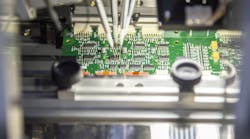ISM: Manufacturing Hangs on to Growth Despite Sliding Orders
The Institute for Supply Management’s latest report on the manufacturing sector shows industry held on to growth despite a serious drop in demand for manufactured goods. In its September survey, released October 3, the ISM said its PMI for manufacturing growth dropped from 52.8% to 50.9%, a drop of 1.9 points and the index's lowest point since May 2020.
Of the three main indexes used to calculate the PMI, two—new orders and employment—dropped, while the third, production, rose slightly. The ISM’s new orders index fell from 51.3% to 47.1%, returning to contraction after one month of growth in August, and the employment index fell 5.5 points to 48.7%. The production index, meanwhile, rose by one-fifth of a percentage point to 50.6%, sustaining its 28-month growth streak alongside the main index.
In a statement, Timothy Fiore, Chair of the ISM’s Business Survey Committee, said the report reflects manufacturers anticipating a slowdown in demand, which has remained elevated since the beginning of the pandemic.
“Following four straight months of panelists’ companies reporting softening new orders rates, the September Index reading reflects companies adjusting to potential future lower demand,” Fiore said.
A handful of survey respondents affirmed the ISM’s findings. “Production is steady, allowing reduction of backlog amidst slightly softened demand,” reported an executive in the transportation equipment industry. A chemical products-company executive said worry about a “global economic slowdown” is increasing, leading to fewer orders.
Several respondents reported improving but sharply uneven supply availability, particularly effecting electrical and electronic components. The ISM listed electrical and electronic components as up in price for 22 months straight as of September. Electronic components and semiconductors have also been in short supply for 22 months, while electrical components have been in short supply for two straight years.
Two survey respondents specifically noted the unevenness of electrical parts. One, from a computers and electronic products company, blamed “capacity and skilled labor shortages” for “supply chain issues for all electronic components and custom build-to-print materials.” Another, from an executive at an electrical equipment or appliances company, said simply, “electrical and wiring components continue to cause significant issues,” and that their company “cannot run as consistently as we would like.”




